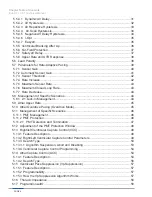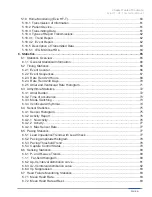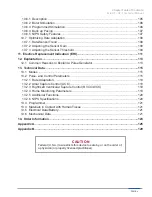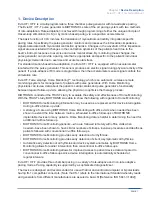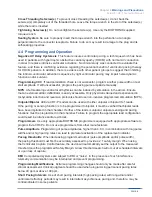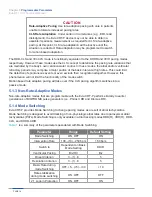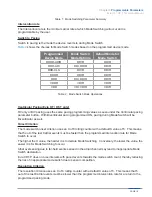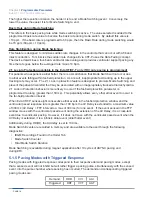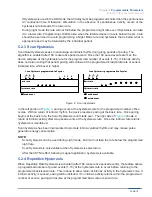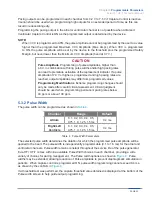
Chapter 4
Warnings and Precautions
Evia HF / HF-T Technical Manual
PAGE 8
Electrocautery
Electrocautery should never be performed within 15 cm (6 inches) of an implanted
pulse generator or lead because of the danger of introducing fibrillatory currents into the heart and/
or damaging the pulse generator. Pacing should be asynchronous and above the patient’s intrinsic
rate to prevent inhibition by interference signals generated by the cautery. When possible, a bipolar
electrocautery system should be used.
For transurethral resection of the prostate, it is recommended that the cautery ground plate be placed
under the buttocks or around the thigh, but not in the thoracic area where the current pathway could
pass through or near the pacing system.
4.2 Storage and Sterilization
Storage (temperature)
Recommended storage temperature range is -10° to 45°C (14°-113°F).
Exposure to temperatures outside this range may result in pulse generator malfunction (see
Section 8.1).
Handling
Do not drop. If an unpackaged pulse generator is dropped onto a hard surface, return it to
BIOTRONIK (see Section 8.1).
FOR SINGLE USE ONLY
Do not resterilize the pulse generator or accessories packaged with the
pulse generator, they are intended for one-time use.
Device Packaging
Do not use the device if the packaging is wet, punctured, opened or damaged
because the integrity of the sterile packaging may be compromised. Return the device to BIOTRONIK.
Storage (magnets)
Store the device in a clean area, away from magnets, kits containing magnets,
and sources of electromagnetic interference (EMI) to avoid damage to the device.
Temperature Stabilization
Allow the device to reach room temperature before programming or
implanting the device. Temperature extremes may affect the initial device function.
Use Before Date
Do not implant the device after the USE BEFORE DATE because the device sterility
and longevity may be compromised.
4.3 Lead Connection and Evaluation
The pulse generator requires atrial and ventricular leads with IS-1 compatible connectors. There are
no requirements specific to the atrial lead. It is required to use a low polarization ventricular lead for
activation of Ventricular Capture Control.
Lead Check
The Evia HF / HF-T pulse generators have an automatic lead check feature which may
switch from bipolar to unipolar pacing and sensing without warning. This situation may be inappropriate
for patients with an Implantable Cardioverter Defibrillator (ICD).
Lead/pulse Generator Compatibility
Because of the numerous available 3.2-mm configurations (e.g.,
the IS-1 and VS-1 standards), lead/pulse generator compatibility should be confirmed with the pulse
generator and/or lead manufacturer prior to the implantation of a pacing system.
IS-1, wherever stated in this manual, refers to the international standard, whereby leads and generators
from different manufacturers are assured a basic fit. [Reference ISO 5841-3:1992(E)].
Lead Configuration
Lead configuration determines proper programming of the pulse generator. Pacing
will not occur with a unipolar lead if the lead configuration is programmed to bipolar (see Section 9).
Setscrew Adjustment
Back-off the setscrew(s) prior to insertion of lead connector(s) as failure to do
so may result in damage to the lead(s), and/or difficulty connecting lead(s).
Summary of Contents for Evia HF
Page 1: ...Cardiac Rhythm Management Heart Failure Therapy Evia HF HF T Evia HF HF T Technical Manual...
Page 8: ...Chapter Table of Contents Evia HF HF T Technical Manual PAGE vi...
Page 12: ...Chapter 2 Indications Evia HF HF T Technical Manual PAGE 4...
Page 14: ...Chapter 3 Contraindications Evia HF HF T Technical Manual PAGE 6...
Page 98: ...Chapter 7 Product Storage and Handling Evia HF HF T Technical Manual PAGE 90...
Page 104: ...Chapter 9 Lead Connection Evia HF HF T Technical Manual PAGE 96...
Page 118: ...Chapter 10 Elective Replacement Indication ERI Evia HF HF T Technical Manual PAGE 110...
Page 130: ...Chapter 13 Order Information Evia HF HF T Technical Manual PAGE 122...
Page 132: ...Chapter 14 Order Information Evia HF HF T Technical Manual PAGE 124...
Page 136: ...PAGE 128 Appendix A Evia HF HF T Technical Manual...



